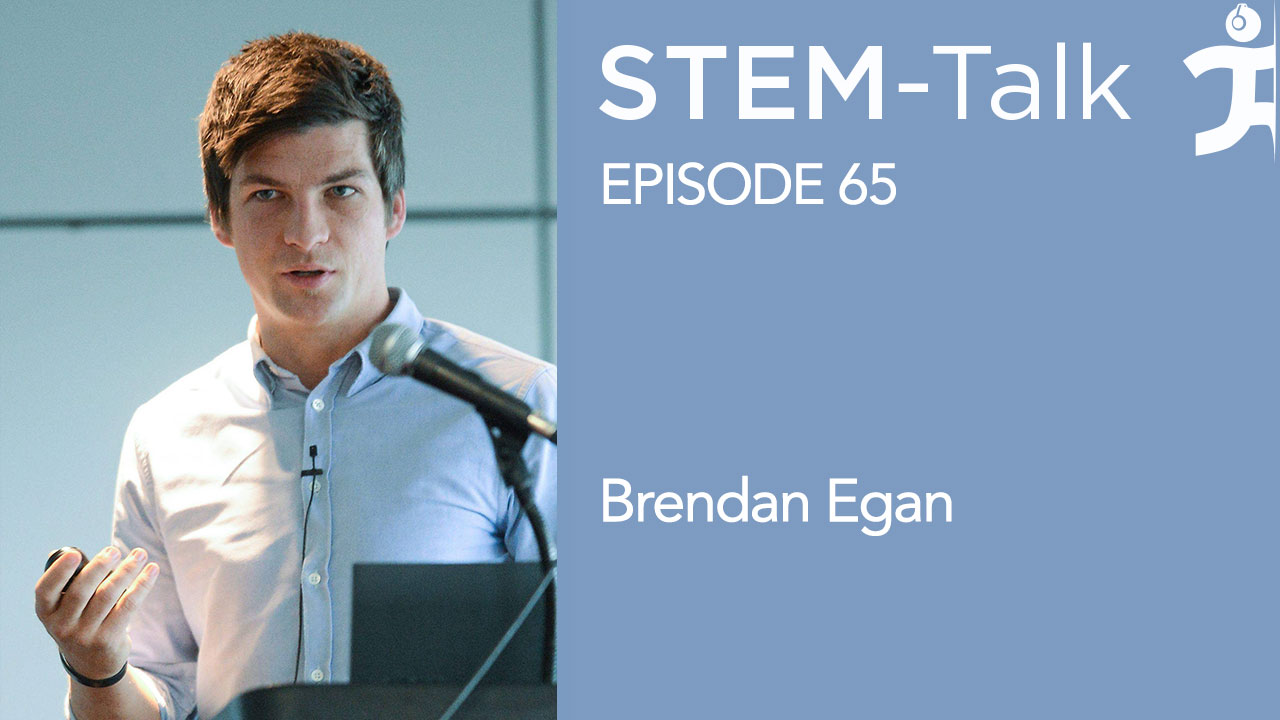STEM-Talk
Episode 65: Dr. Brendan Egan talks about the importance of muscle and his research into exogenous ketones
// Jun 5, 2018

Dr. Brendan Egan is an Associate Professor of Sport and Exercise Physiology at Dublin City University who is well known for research that shows resistance training can improve strength, muscle mass, reduce falls in older people, and perhaps even extend lifespans.
In addition to being a first-class researcher, Brendan is also a stand-out player in Ireland’s national sport, Gaelic football.
His current research is exploring the synergy between nutrition and exercise interventions to optimize performance in athletes and the elderly.
Current projects also involve protein hydrolysates in recovery and glycemic management; leucine and n-3 PUFAs in the elderly; and exogenous ketones and athletic performance.
Links:
Brendan Egan’s faculty page:
https://dcu.academic.ie/live/!W_VALOCAL_DCU_PORTAL.PROFILE?WPBPRSN=1631629
Brendan Egan’s Researchgate profile
https://www.researchgate.net/profile/Brendan_Egan2/contributions
Brendan Egan’s TEDx talk:
Exercise Metabolism and the Molecular Regulation of Skeletal Muscle Adaptation
https://www.sciencedirect.com/science/article/pii/S1550413112005037
Metabolism of ketone bodies during exercise and training:
https://physoc.onlinelibrary.wiley.com/doi/epdf/10.1113/JP273185
Fueling performance: Ketones Enter the Mix:
https://www.cell.com/cell-metabolism/fulltext/S1550-4131(16)30438-7
Does Strength-Promoting Exercise Confer Unique Health Benefits?
https://academic.oup.com/aje/article-abstract/187/5/1102/4582884?redirectedFrom=fulltext
Does Strength-Promoting Exercise Confer Unique Health Benefits?
https://physoc.onlinelibrary.wiley.com/doi/full/10.1113/JP275938
Show notes:
2:46: Dawn opens by mentioning that Brendan was born in Detroit, and that his Irish father moved the family to Ireland when Brendan was 3 years old. Dawn asks if Brendan’s mother was American.
4:09: Dawn comments on how Brendan was very athletic as a child and played Gaelic football, which is Ireland’s national sport, and asks if he could explain how this game is played.
6:02: Ken, following up on the last question, asks what Brendan’s training is like for this sport, and how he manages to fit it into his busy schedule as a professor.
7:41: Dawn asks if it is true that even though Brendan’s best grades were in math and physics, he never considered a career in science while he was in high school.
8:37: Dawn mentions that Brendan ended up at the University of Limerick after graduating, asking what made him decide to attend Limerick as well as what prompted him to major in sports and exercise science.
9:46: Dawn asks about two people, Phil Jakeman and John Kirwan, who played a big role in shaping Brendan’s education at Limerick.
11:58: Dawn comments on how after completing his bachelor’s of science degree, Brendan went to work on his master’s, heading to the UK and attending Loughborough University where he graduated with distinction in sports exercise and nutrition. Dawn asks what made him decide to attend Loughborough, and what stood out about his time there.
13:33: Dawn mentions that Brendan returned to Ireland in 2004 to start his doctoral studies under the supervision of Dr. Donal J O’Gorman at Dublin City University. Dawn asks what that experience was like.
15:06: Ken asks what Brendan learned from his research with Dr. O’Gorman, which focused on skeletal muscle adaptation to exercise and, in particular, continuity between acute molecular responses to individual bouts of exercise and the adaptations in skeletal muscle induced by exercise training.
18:30: Dawn asks what took Brendan to Karolinska Institute in Stockholm.
19:51: Brendan talks about his work at Karolinska using animal intravenous cell systems, and his research into transcriptional regulation of skeletal muscle insulin resistance and type 2 diabetes utilizing small non-coding RNA’s.
23:39: Ken mentions that Brendan’s first faculty position was at the University College Dublin in 2011, where he spent five years establishing his own independent research group. He then moved to Dublin City University in 2016. Ken asks how Brendan developed his research group, and what kind of work the group does now.
25:44: Dawn asks Brendan to discuss the prevalence of the age-related loss of muscle function and mass, which often leads to sarcopenia. She also asks about its effects on individuals as well as its impact on society.
27:45: Ken mentions that the heavy use of Prednisone, which a lot of older people are put on for long periods of time, rapidly diminishes their muscle mass.
29:35: Ken mentions that falls are a huge issue, seemingly associated with the loss of fast-twitch muscle as we age, and that falls are more a result of loss of power than loss of strength and mass. He proposes that this is a major, yet overlooked, driver of the prevalence of falling in the older population.
31:11: Ken comments on how there are complex and interacting causes of this loss of mass, strength and power which are not completely understood yet. He lists off certain drivers such as: insulin resistance; decreased availability of anabolic hormones coupled with increased anabolic resistance; the need for more protein as we age; decreased motor neuron function; elevated intercellular oxidative stress; reduction in satellite cell numbers and regenerative capacity; elevated myostatin signaling; reduced physical activity; increased chronic inflammation; changes in autophagy; and mitochondrial abnormalities. Ken asks Brendan to share his thoughts on what he considers the primary drivers of muscle loss.
33:06: Dawn mentions that one of Brendan’s most recent research studies is centered on the optimal way to exercise in terms of time efficiency. She inquires as to what the best combination of exercise would be for someone with a limited amount of time per week.
35:53: Dawn asks Brendan to talk about the importance of leg strength.
37:05: Dawn mentions that it has been well established for many years that resistance training can improve strength and muscle mass, and reduce the incidence of falls and fractures. She asks Brendan to talk about a recent study, done over the course of 15 years with more than 30,000 participants 65 years and older. The study showed that people who did strength training twice a week lowered their risk of dying by almost half.
38:33: Dawn asks what Brendan found in a follow-up study he did where he looked at a nutrition intervention that featured a high protein diet in combination with exercise versus a high protein diet alone. Unlike most similar studies, Brendan’s follow-up study used whole foods rather than protein supplements.
40:47: Dawn mentions that Brendan and other scientists at UCD are currently investigating a dairy-based protein which has been predigested from hydrolysate to see if it will enhance the insulin response and lead to a faster recover compared to other protein and carbohydrate drinks.
42:06: Ken comments on how optimal recovery post-exercise is more and more appreciated, and it’s obviously desired across athletic populations. He asks what happens at the cellular and molecular level during recovery that Brendan finds most relevant and interesting.
43:50: Dawn mentions that Brendan has been looking at exogenous ketone supplementation, particularly in the area of sport science, and how it might relate to athletic performance, and asks what this research is specifically focused on at the moment.
44:41: Ken asks Brendan for his thoughts on increasing the circulating availability of BHB by consumption of exogenous ketones and wonders if it would recapitulate the many positive effects of decreasing carbohydrate intake, which manifests itself in those engaged in a keto-adapted phenotype.
46:20: Dawn mentions that in some circles there is concern that one might overload the mitochondria by providing both high levels of glucose and ketones, asking what Brendan’s thoughts are on this.
47:23: Dawn asks what we know about the impact of exogenous ketones in athletic performance.
51:36: Dawn asks about exogenous ketone esters, particularly the HVMN monoester. She also asks about the AcAc diester developed by Dominic D’Agostino. She supposes that the two different compounds would have distinct pharmacokinetics and somewhat different effects. She asks Brendan to discuss this.
54:39: Dawn mentions that Brendan has given ketone salts and esters to athletes, and that there’s talk in the community about the tolerability of these different compounds. She asks about his experience with them and how he has improved the tolerability in his studies.
56:02: Ken asks about the effects of exogenous ketones on carbohydrate metabolism in high intensity sport, and what he thinks of the glycogen sparing versus glycogen impairing debate around exogenous ketones.
1:00:39: Dawn mentions that exogenous ketones lower blood glucose, asking what the role of the hepatic glucose output is, versus the change in peripheral uptake, and asks Brendan if he thinks BHB could be altering peripheral glucose uptake.
1:02:24: Ken asks about Brendan’s thoughts on studies concluding that exogenous ketone esters helped blood ketone concentrations reach greater than 2 millimolar and is likely a key mediator of any potential ergogenic effect.
1:03:32: Ken mentions the topic of recovery, pointing out that there have been several papers in recent years that look at the BHB monoester and recovery. Ken asks Brendan to discuss these studies and their implications for future research.
1:07:10: Dawn asks if exogenous BHB might have the same effect as exercise, which has long been known to increase brain derived neurotrophic factor (BDNF) which enhances mental abilities, reduces anxiety, and increases neuroplasticity, considering that BDNF has been shown to be inhibited by histone deacetylases (HDACs), and that BHB inhibits HDACs.
1:08:21: Ken mentions that there have been a few ingestibles that have had effects that act as exercise mimetics. He inquires as to Brendan’s thoughts on these compounds.
1:10:14: Dawn asks Brendan about how Ireland is projected to become the fattest nation in Europe in the next 10 to 15 years.
1:11:07: To wrap things up, Dawn asks Brendan to give three to five pieces of advice for living a longer and healthier life, no matter the age.






